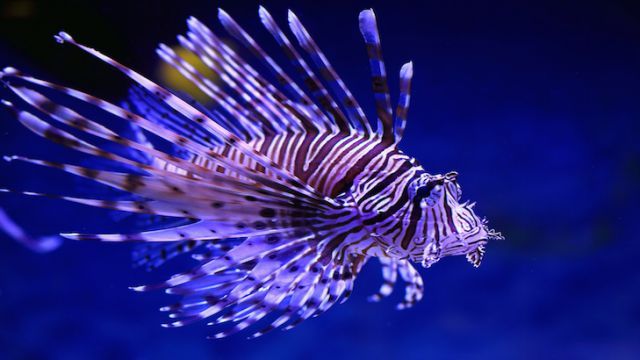
Lionfish are native to reefs and rocky areas in the Indian and Pacific oceans, but can now be found pretty much anywhere there is warm water. These exotic-looking and venomous spiked fish are quickly growing invasive populations most abundantly off the coast of Florida, in the Caribbean and have now been spotted in the Mediterranean near Turkey and Cyprus.
While experts aren’t sure exactly how the lionfish began setting up invasive populations in these waters, a few theories exist. Lionfish, because of their beautiful and exotic appearance, have also been a very popular species for amateur aquarium enthusiasts. Unfortunately, as has been the case with numerous invasive species in the past, once these aquarium enthusiasts grow tired of caring for the invasive species, they dispose of them by dumping them in the ocean.
Another theory is that the invasive population was caused when several lionfish escaped an aquarium during Hurricane Andrew in 1992, however, there were reported sightings of lionfish off the coast of Florida before this occurred.
While most invasive species are not able to adapt to their new surroundings and increase their population, lionfish have the complete trifecta of characteristics that allow an invasive population to grow:
No natural predators
In their new habitat, lionfish have no natural predators. Additionally their long, venomous spikes deter potential new predators from adding them to their menu.
Diverse food sources
Lionfish eat a wide variety of marine life, mainly focusing on fish, shrimp and crab. They generally feed once per day usually from around 7 a.m. to 11 a.m.; they are very much a breakfast species that way. It is not uncommon for a lionfish to ingest as many as six different food sources during one breakfast session.
They reproduce like crazy
The most problematic characteristic an invasive species can have is the ability to reproduce rapidly, and the lionfish take this to a whole new level. A female lionfish can lay as many as 2 million eggs per year, and can begin reproducing within the first year of her life.
With no natural predators, enough food to eat and an ability to reproduce rapidly, lionfish populations have exploded and decimated fish and shrimp populations in the non-native areas where they are now commonly found.
Can lionfish kill people?
The sting from a lionfish is extremely painful to humans, but rarely fatal. Their spikes are only for defensive purposes; they won’t seek out a human to sting them. Basically you have to sting yourself with a lionfish by brushing up against one, accidentally stepping on them or handling one. Even handling a dead lionfish carries a risk to it, as numerous stings have been reported from someone putting their hand in a cooler that contained a lionfish.
If stung the best course of action is to rinse and clean the wound, apply heat and go see a doctor. Unfortunately, unlike with jellyfish stings, urinating on the wound is not helpful, but it doesn’t hurt either.
What is being done?
Lionfish derbies
Lionfish derbies are one-day competitions, usually held by a local environmental group or community association, where divers and snorkelers work in teams to literally remove lionfish from the water. Through using spears or nets, the teams will catch as many as they can in a day and generally an event will have awards and prizes handed out afterward. As lionfish are safe to eat when prepared correctly, participants can also feast on the catch following the day’s activities.
If you are in the Florida area and are interested in taking part in a lionfish derby, more information can be found here.
In addition to removing more than 1,000 lionfish a day, these derbies can also serve as a great education and outreach tool to build awareness about the impacts of invasive populations.
Training sharks
Efforts are underway off the coast of Honduras and Cuba to try and give sharks a taste for lionfish. Sharks will eat lionfish, and are immune to their venomous stings, but questions remain about how effective this technique will ultimately be.
In order to accomplish this the divers will spear a lionfish and swim near reef sharks with the speared fish dangling in tempting fashion. While this cannot be confirmed, it is almost certain that many of the divers mouth the words “here sharky sharky” during this process.
Critics state that this can be a dangerous practice, as sharks could become conditioned to seeing human divers in the water and expecting a free meal.
A population eating itself?
An unlikely ally in the fight to remove lionfish from these waters appears to have emerged: cannibal lionfish. There have now been reports that lionfish appear to be eating each other from time to time, possibly a symptom of the species having eaten through their other food stocks. While it is rare, a small sample study collected showed that out of 130 caught lionfish, four were in the process of digesting other lionfish.
Whole Foods
In addition to high-priced gluten-free breads and organic produce, Lionfish is now being sold at several Whole Foods stores — a recent addition. In what is hopefully the beginning of a booming market, lionfish are potentially a good revenue source for the fishing industry. Not only is there no catch limit on lionfish, as with many other species, their removal from the water is encouraged.
That lionfish are now being sold in grocery stores is perhaps an important threshold for us to cross. In order for our society to really have the necessary tools to deal with a problem this pervasive, there has to be a dollar figure put on it. Currently that dollar figure is listed at $9.99 a pound.
Just don’t eat the spikes.
—Ian Carey

